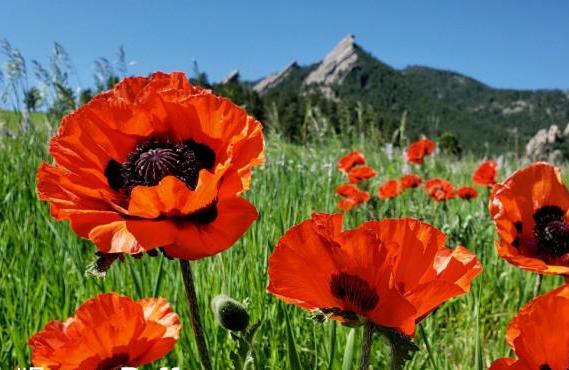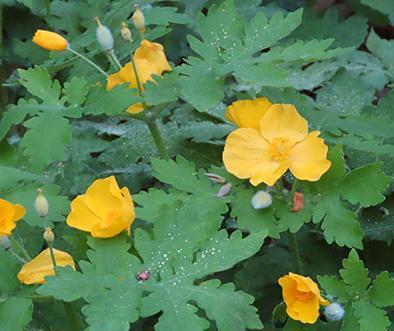Popular Poppies
By Ray Novitske, Fairfax Master Gardener

Oriental Poppy
Because I grow annual poppies in my front garden every year that impress my neighbors, I wanted to write about them. But I also killed a perennial Oriental Poppy plant that I purchased many years ago. Older and a little wiser, I now know that it did not receive the proper growing conditions, and I did not understand its life cycle.
Who knew that there were so many different types? There is a native poppy that grows on every populated continent. Let’s examine some of the more popular ones that you might find enticing, and one type that gardeners want to grow, but most cannot.
Oriental Poppy
Papaver orientale is the popular poppy that most people visualize when they hear the word poppy. This bright orange or red perennial has tissue paper petals with large blooms and usually a black ringed center. Native to Asia, Turkey and the Caucuses where winters are cold and summers dry, these were the first poppies to be brought to Europe and hybridized to produce some pink and white colors.
The leaves are hairy and thistle-like and the 3-foot tall (90 cm) stems often need staking. They prefer cool, well-drained soil, and do not do well in our hot humid summers. After blooming in late spring, they die back for the summer with foliage reappearing in the fall and often persisting throughout the winter as it readies for blooming the following spring.
Like all poppies, the Oriental Poppy does not like to be transplanted, and may take a few seasons to bloom if planted from seed. If sown in the garden, note that poppies are one of the plants that need light to break dormancy and germinate.

Shirley Poppy
Shirley Poppy
Although naturalized throughout the U.S, Papaver rhoeas is native to Europe and often called the Flanders Poppy because of its association with World War I and the city of Flanders. After heavy casualties in a battle at Flanders, these poppies quickly appeared on the freshly dug graves there, with some people accepting this as a divine sign. Actually, poppy seeds can remain in the soil for years before the right light conditions occur to germinate. Disturbing the soil most likely caused the long dormant poppy seeds to germinate. Today, this red poppy is worn on Remembrance Day (similar to our Veteran’s Day) in Europe, and especially England.
The Shirley Poppy is an annual that readily reseeds itself and comes in blooms of pink, white and red. The 3-inch (7 cm) flower is held well above the 2-foot high (60 cm) stem and small foliage, allowing it to be easily visible and appreciated. Grow this in well-drained soil and in full or part sun.

Opium Poppy ‘Lauren’s Grape’
Opium Poppy
Sometimes called the breadseed poppy because of its use on baked goods, Papaver somniferum is used to produce opium and heroin. It is grown as an ornamental in the U.S. The DEA has stated that “it is illegal to grow [these poppies] for the purpose of producing opiates.” Although it is illegal to grow because of its classification as a schedule II narcotic, you can purchase seeds from many seed companies, and the DEA will not come knocking on your door (unless you are growing a large area, like an acre.)
These poppies are native to Central Asia and the Mediterranean. Flowers come in many shades of pink, white and lavender, with blueish green smooth leaves, and can have the characteristic tissue-paper petals or resemble peonies and carnations. ‘Lauren’s Grape’ is a specific, single-flowered, popular lavender variety. An annual, it easily reseeds itself each year. It thrives in rich soil, sunny locations and cool temperatures, and does poorly in hot humid weather. In our area, seeds are often sown in fall for a later spring bloom.

Woodland Poppy
Woodland Poppy
Perennial Stylophorum diphyllum, or sometimes called the Celandine Poppy, is native to the shady woodlands of Virginia and the eastern U.S. It is considered endangered in the wild in some areas. It prefers wet, humusy soils found among fallen leaves and part to full shade. It will go dormant in early summer if the soil dries out.
The yellow flower blooms in early spring on 12- to 18-inch high (30 to 50 cm) plants. The orange sap can easily stain and was used by Native Americans as a dye.

California Poppy
California Poppy
Eschscholzia californica is a cool season annual found wild in the western U.S. and in cultivated gardens. Its low-growing, trailing habit produces red, orange, yellow and white flowers, although it is mostly found as orange. Flowers above the lacy foliage close up on cloudy rainy days and at night. It is at home in sunny spots with dry, poor soils and is considered a drought-tolerant cool season annual.
It can easily grow in our area. Sow seeds directly in the ground in the fall or start indoors about three weeks before the last frost. This will continue blooming throughout the spring if deadheaded to prevent seed production.

Himalayan Poppy
Himalayan Poppy
Meconopsis is a genus within the Papaveraceae or poppy family. These rare blue poppies are native to the high elevations of the Himalayan Mountains and are almost extinct in their natural habitat. Gardeners seek out these because of the color, but they are very difficult to grow. They originate from the high elevations of the Himalayans and require low temperatures, snow cover in winter to protect from freezing temperatures, acid soils, semi-woodland areas and cool damp summers. They will die if temperatures reach over 80 degrees, so forget about growing them here.
The cultivar ‘Lingholm’ is offered in some seed catalogs. But, be warned that this poppy is a challenge, even for the best gardeners.
If trying poppies in your garden, try the annual poppies first. Be sure to sow them in the fall, and enjoy them in the spring.
Resources
• Plant of the Week: Poppy, Oriental, University of Arkansas Cooperative Extension System
• Papaver orientale, North Carolina State University Extension
• Papaver somniferum, Purdue University Center for New Crops and Plants Products
• Massive Poppy Bust: Why Home-Grown Opium is Rare, Live Science
• Indictment: Kansas man planted poppies …, U.S. Drug Enforcement Administration, Drug Enforcement
Adminstration
• Corn Poppy/Shirley Poppy, Texas A&M University
• Plant of the Week: Polly (Field Poppy, Flanders Poppy, Corn Poppy), University of Arkansas
Cooperative Extension Service
• Celandine Poppy, Stylophorum diphyllum, University of Wisconsin-Madison Division of Extension
• Stylophorum diphyllum, Missouri Botanical Garden
• Eschscholzia californica, North Carolina State University Extension
• Papaver nudicaule, Arizona State University
• Blue-poppy, Longwood Gardens
• The Himalayan Blue Poppy, Meconopsis ‘Lingholm,’ University of Illinois